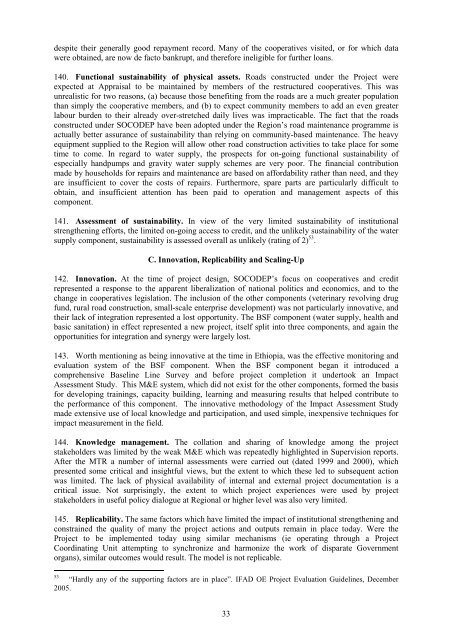Ethiopia SOCODEP CE - main report - IFAD
Ethiopia SOCODEP CE - main report - IFAD
Ethiopia SOCODEP CE - main report - IFAD
You also want an ePaper? Increase the reach of your titles
YUMPU automatically turns print PDFs into web optimized ePapers that Google loves.
despite their generally good repayment record. Many of the cooperatives visited, or for which data<br />
were obtained, are now de facto bankrupt, and therefore ineligible for further loans.<br />
140. Functional sustainability of physical assets. Roads constructed under the Project were<br />
expected at Appraisal to be <strong>main</strong>tained by members of the restructured cooperatives. This was<br />
unrealistic for two reasons, (a) because those benefiting from the roads are a much greater population<br />
than simply the cooperative members, and (b) to expect community members to add an even greater<br />
labour burden to their already over-stretched daily lives was impracticable. The fact that the roads<br />
constructed under <strong>SOCODEP</strong> have been adopted under the Region’s road <strong>main</strong>tenance programme is<br />
actually better assurance of sustainability than relying on community-based <strong>main</strong>tenance. The heavy<br />
equipment supplied to the Region will allow other road construction activities to take place for some<br />
time to come. In regard to water supply, the prospects for on-going functional sustainability of<br />
especially handpumps and gravity water supply schemes are very poor. The financial contribution<br />
made by households for repairs and <strong>main</strong>tenance are based on affordability rather than need, and they<br />
are insufficient to cover the costs of repairs. Furthermore, spare parts are particularly difficult to<br />
obtain, and insufficient attention has been paid to operation and management aspects of this<br />
component.<br />
141. Assessment of sustainability. In view of the very limited sustainability of institutional<br />
strengthening efforts, the limited on-going access to credit, and the unlikely sustainability of the water<br />
supply component, sustainability is assessed overall as unlikely (rating of 2) 53 .<br />
C. Innovation, Replicability and Scaling-Up<br />
142. Innovation. At the time of project design, <strong>SOCODEP</strong>’s focus on cooperatives and credit<br />
represented a response to the apparent liberalization of national politics and economics, and to the<br />
change in cooperatives legislation. The inclusion of the other components (veterinary revolving drug<br />
fund, rural road construction, small-scale enterprise development) was not particularly innovative, and<br />
their lack of integration represented a lost opportunity. The BSF component (water supply, health and<br />
basic sanitation) in effect represented a new project, itself split into three components, and again the<br />
opportunities for integration and synergy were largely lost.<br />
143. Worth mentioning as being innovative at the time in <strong>Ethiopia</strong>, was the effective monitoring and<br />
evaluation system of the BSF component. When the BSF component began it introduced a<br />
comprehensive Baseline Line Survey and before project completion it undertook an Impact<br />
Assessment Study. This M&E system, which did not exist for the other components, formed the basis<br />
for developing trainings, capacity building, learning and measuring results that helped contribute to<br />
the performance of this component. The innovative methodology of the Impact Assessment Study<br />
made extensive use of local knowledge and participation, and used simple, inexpensive techniques for<br />
impact measurement in the field.<br />
144. Knowledge management. The collation and sharing of knowledge among the project<br />
stakeholders was limited by the weak M&E which was repeatedly highlighted in Supervision <strong>report</strong>s.<br />
After the MTR a number of internal assessments were carried out (dated 1999 and 2000), which<br />
presented some critical and insightful views, but the extent to which these led to subsequent action<br />
was limited. The lack of physical availability of internal and external project documentation is a<br />
critical issue. Not surprisingly, the extent to which project experiences were used by project<br />
stakeholders in useful policy dialogue at Regional or higher level was also very limited.<br />
145. Replicability. The same factors which have limited the impact of institutional strengthening and<br />
constrained the quality of many the project actions and outputs re<strong>main</strong> in place today. Were the<br />
Project to be implemented today using similar mechanisms (ie operating through a Project<br />
Coordinating Unit attempting to synchronize and harmonize the work of disparate Government<br />
organs), similar outcomes would result. The model is not replicable.<br />
53 “Hardly any of the supporting factors are in place”. <strong>IFAD</strong> OE Project Evaluation Guidelines, December<br />
2005.<br />
33

















